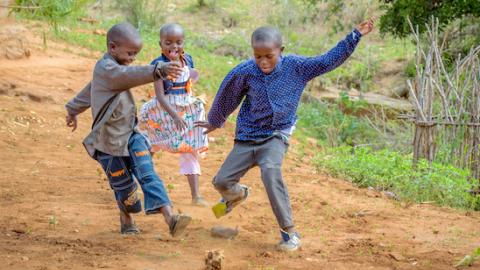
Objectives: World Vision Kenya (2021-2025) Strategy
Objective 1: Children report an increased awareness of God’s love
To ensure that children have improved relationship with God, enhanced self-image and esteem, enriched relationship with parents and peers, therefore generating hope for brighter futures, we will:
-
Focus on targeting the most vulnerable children through the faith leaders and faith based organisations.
-
Empower parents and caregivers with the appropriate knowledge, values, skills and behaviour to care and love children in stable and unstable contexts. This will include priori sing value based parenting competencies including those that help them protect children from all forms of violence.
-
Strengthen the capacity of the church and other faith institutions to advocate for child well-being and be more involved in designing and implementing community development projects.
-
Focus on religious programmes for children both at the church and in schools; and ensure the functionality of spiritual nurture clubs. This will include empowering church and school teachers with the required spiritual nurture of children values, knowledge, skills and approaches that will make them effective in integration of the same with life issues.
-
Sustain prayer and scripture reflection on programmes at home and school.
Objective 2: Increase in girls and boys protected from violence
To ensure that all children are protected from all forms of violence, we will:
- Empower children, parents, caregivers and all adult members of households with knowledge and skills to enable them take daily sustainable ac ons for protecting children from physical and sexual violence, child marriage, Female Genital Mu la on (FGM), child labour, child exploitation and other forms of violence.
- Strengthen child participation platforms such as children’s clubs and assemblies so as to enable children to participate more meaningfully and be involved in decision making processes at the household, community, institutions and other levels of governance in Kenya.
- Strengthen capacities of community-based child protection and advocacy groups/structures, churches, faith-led groups, learning institutions, government ins tu ons and children support services. These efforts will enable the groups and institutions to enhance child participation and to provide sustainable, equitable and quality child protection monitoring, reporting and referral services, including during emergencies.
- Continuously advocate for the implementation and enforcement of laws and policies that protect children from all forms of violence. This will include advocating for sustainable and equitable alloca on of the public budget to programmes that contribute to increased protection of children from all forms of violence
Objective 3: Increase in children protected from infection and disease (0-5 years).
To ensure that children are protected from infection and diseases, we will:
-
Contribute to improved access to adolescent responsive health services, which include both preventive and promotive services that help adolescent girls to overcome early child marriage and pregnancies, and to seek age-appropriate health services. We will also advocate for increased access to youth friendly services.
-
Contribute to improved access to health care for mothers and children through collaborations with partners and the government to implement programmes that contribute to increased access to quality health services, including adequate health supplies and staff . We will also promote good health seeking behaviour, scale up access to mental health services and strengthen community health structures.
-
Contribute to the reduced prevalence of Water, Sanitation and Hygiene (WASH) related diseases through an integrated approach, which includes the long-term sustainability of water sources, through the Integrated Water Resource Management (IWRM) approach. We will also strengthen partnerships with the Government and communities to enhance basic sanitation by promoting adoption of basic sanitation facilities, solid waste management and access to safe hygiene practices.
Objective 4: Increase in children 0-6 year experience quality care and education
To ensure that all children experience quality care and education, we will:
- Empower parents and caregivers to provide nurturing and responsive care to enhance the healthy development of the body and mind of children aged 0 to 3 years. As the first teachers of their children in life, we will also empower parents to be able to impart effective skills that will enable children to attain independence and lead healthy and successful lives.
- Strengthen pre-primary school programmes for boys and girls (4-6 year-old) to enable them acquire the requisite competencies to transit to primary school. We will work with the government, partners and stakeholders to ensure that children access quality and prompt Early Childhood Development (ECD) education services for school readiness, as well as advocate for improved quality and access to both primary and secondary education in the country.
- Empower parents and caregivers to accord children responsive care by ensuring that they have the resources and skills to provide safe, stable, nurturing and stimulating care. We will also endeavour-in collaboration with the government, partners and Community Based Organisations (CBOs) to equip parents with effective caregiving practices that promote the holistic development of children.
- Advocate for, and support an integrated approach to ECD that aligns with the Nurturing Care Framework, where key supportive services and interventions will be incorporated to ensure that children (0 to 6 years old) in fragile rural areas, urban informal settlements and refugee settings receive timely and quality ECD services.
- Empower communities to ensure children have access to food and nutrition security in an environment/family/community settings in different contexts, like the informal urban settlements, refugee setting and other fragile context, such us communities living in Arid and Semi-Arid Lands (ASALs). This will be achieved by ensuring increased access, availability, stability and utilisation on of safe, diverse and nutritious food varieties through imparting skills and supporting technologies that include equipping parents with knowledge and child care practices that are significant in the first 1,000 days of child development.